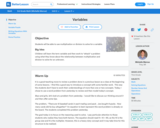
The big idea of this lesson is that students can solve for near doubles by thinking of the related doubles fact.
- Subject:
- Mathematics
- Material Type:
- Lesson Plan
- Provider:
- BetterLesson
- Date Added:
- 12/01/2022

The big idea of this lesson is that students can solve for near doubles by thinking of the related doubles fact.

Students will be able to see the relationship between theoretical probability and experimental probability by computing both at the same time.

Kindergarteners love to identify shapes in their environment. In order effectively do that, they must be able to recognize different shapes by their specific attributes. In this lesson kindergartners learn about the attributes of a square.

Were off to get the measure, the wonderful measure of side! The students will identify the longest side of an object and measure its length with a variety of non standard units.

This lesson provides an opportunity for visual learns to think about segments of time during the school day.

As the result of a Unit assessment, it was found that students showed some confusion with writing time and with adding sets of coins. These skills need to be reviewed to aid in mastery of the Common Core standards for time and money.

Students will translate between the written form and algebraic form using correct mathematical notation.

Students will be able to practice working with triangles in different orientations, students will illustrate a "real world" triangular object, & build craft stick triangles.

Kindergarteners love to identify shapes in their environment. In order effectively do that, they must be able to recognize different shapes by their specific attributes. In this lesson kindergartners learn about different types of triangles.

Students develop their understanding of multiplication by grouping objects into equal groups to model the factors and products.

It is important to assess students periodically to plan for future lessons to meet student needs.

Patterns are prevalent in all levels of math. Common Core Standards expect students to be able to use structure - like that found in repeating the patterns of odd and even numbers or counting by 5s or 10s - to solve problems (MP7).

In this multi-day activity, students make 3 different models of an orphanage floor plan using Google Drawing, Virtual Graph paper, and a construction of rectilinear shapes, to calculate the area of each room using units square.

Students have greater engagement in learning when it is organized around gathering and using meaningful data.

The ratio table is a tool that students can use to solve a variety of problems.

Students can solve multiplication and division problems quickly by recognizing the relationship between the two operations.

Children will learn the term variable and then work to "attack" a problem using what they know about the relationship between multiplication and division to solve for an unknown.

Understanding place value is critical to the Common Core Standards for second grade. Without a concrete understanding, students may not fully grasp the meaning of the digits.

Finding different combinations to cover a given pattern block is the idea of the day. Students will create pattern block shapes using other pattern blocks.

This lesson helps build a strong culture of problem solvers, and it can work as an introduction in 1st grade or as a Kindergarten lesson!